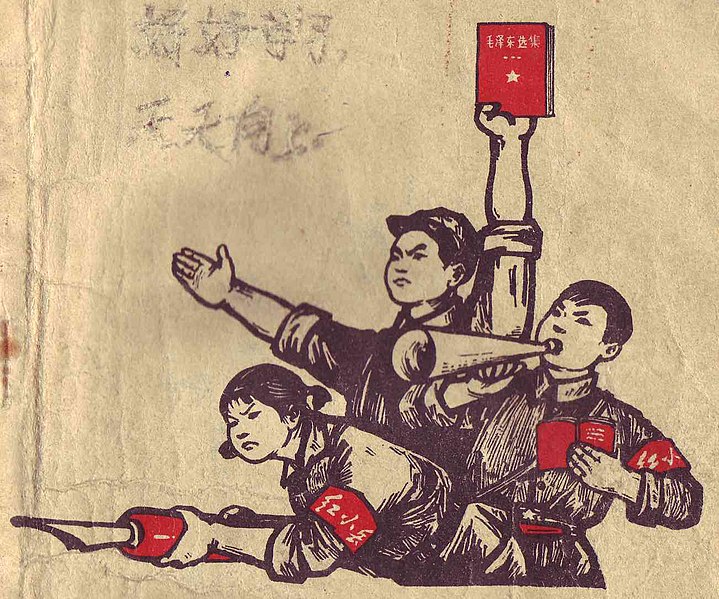Continued from Part 1
The People's Republic of China
In Beijing, on October 1, 1949, Mao Zedong proclaimed the founding of the People's Republic of China (P.R.C.). The new government assumed control of a people exhausted by two generations of war and social conflict, and an economy ravaged by high inflation and disrupted transportation links. A new political and economic order modeled on the Soviet example was quickly installed.
In the early 1950s, China undertook a massive economic and social reconstruction program. The new leaders gained popular support by curbing inflation, restoring the economy, and rebuilding many war-damaged industrial plants. The CCP's authority reached into almost every aspect of Chinese life. Party control was assured by large, politically loyal security and military forces; a government apparatus responsive to party direction; and the placement of party members in leadership positions in labor, women's, and other mass organizations. Meanwhile, the People's Liberation Army took advantage of Soviet shortcomings in foreign policy and supplied many weapons and personnel to the Viet Minh insurgency in French Indochina and deployed parts of the PLA (renamed the "People's Volunteer Army") to fight on behalf of North Korea in the Korean War.
The "Great Leap Forward" and the Sino-Soviet Split
In 1958, Mao broke with the Soviet model and announced a new economic program, the "Great Leap Forward," aimed at rapidly raising industrial and agricultural production. Giant cooperatives (communes) were formed, and "backyard factories" dotted the Chinese landscape. The results were disastrous. Normal market mechanisms were disrupted, agricultural production fell behind, and China's people exhausted themselves producing what turned out to be shoddy, un-salable goods. Within a year, starvation appeared even in fertile agricultural areas. From 1960 to 1961, the combination of poor planning during the Great Leap Forward and bad weather resulted in one of the deadliest famines in human history.
The already-strained Sino-Soviet relationship deteriorated sharply in 1959, when the Soviets started to restrict the flow of scientific and technological information to China. The dispute escalated, and the Soviets withdrew all of their personnel from China in August 1960. In 1960, the Soviets and the Chinese began to have disputes openly in international forums.
The Cultural Revolution
In the early 1960s, State President Liu Shaoqi and his protege, Party General Secretary Deng Xiaoping, took over direction of the party and adopted pragmatic economic policies at odds with Mao's revolutionary vision. Dissatisfied with China's new direction and his own reduced authority, Party Chairman Mao launched a massive political attack on Liu, Deng, and other pragmatists in the spring of 1966. The new movement, the "Great Proletarian Cultural Revolution," was unprecedented in communist China’s history. For the first time, a section of the Chinese communist leadership sought to rally popular opposition against another leadership group. China was set on a course of political and social anarchy that lasted the better part of a decade.
In the early stages of the Cultural Revolution, Mao and his "closest comrade in arms," National Defense Minister Lin Biao, charged Liu, Deng, and other top party leaders with dragging China back toward capitalism. Radical youth organizations, called Red Guards, attacked party and state organizations at all levels, seeking out leaders who would not bend to the radical wind. In reaction to this turmoil, some local People's Liberation Army (PLA) commanders and other officials maneuvered to outwardly back Mao and the radicals while actually taking steps to rein in local radical activity.
Gradually, Red Guard and other radical activity subsided, and the Chinese political situation stabilized along complex factional lines. The leadership conflict came to a head in September 1971, when Party Vice Chairman and Defense Minister Lin Biao reportedly tried to stage a coup against Mao; Lin Biao allegedly later died in a plane crash in Mongolia.
In the aftermath of the Lin Biao incident, many officials criticized and dismissed during 1966-69 were reinstated. Chief among these was Deng Xiaoping, who reemerged in 1973 and was confirmed in 1975 in the concurrent posts of Party Vice Chairman, Politburo Standing Committee member, PLA Chief of Staff, and Vice Premier.
The ideological struggle between more pragmatic, veteran party officials and the radicals re-emerged with a vengeance in late 1975. Mao's wife, Jiang Qing, and three close Cultural Revolution associates (later dubbed the "Gang of Four") launched a media campaign against Deng. In January 1976, Premier Zhou Enlai, a popular political figure, died of cancer. On April 5, Beijing citizens staged a spontaneous demonstration in Tiananmen Square in Zhou's memory, with strong political overtones of support for Deng. The authorities forcibly suppressed the demonstration. Deng was blamed for the disorder and stripped of all official positions, although he retained his party membership.
See the book Son of the Revolution by Liang Heng for a firsthand account of growing up through the litreral terror of the Cultural Revolution.
Continued in Part 3: The Post-Mao Era and Tiananmen Square.
Image used is in the public domain and was obtained from Wikimedia Commons.


No comments:
Post a Comment